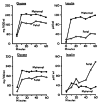In utero fuel homeostasis: Lessons for a clinician
- PMID: 23776854
- PMCID: PMC3659908
- DOI: 10.4103/2230-8210.107851
In utero fuel homeostasis: Lessons for a clinician
Abstract
Fetus exists in a complex, dynamic, and yet intriguing symbiosis with its mother as far as fuel metabolism is concerned. Though the dependence on maternal fuel is nearly complete to cater for its high requirement, the fetus is capable of some metabolism of its own. The first half of gestation is a period of maternal anabolism and storage whereas the second half results in exponential fetal growth where maternal stores are mobilized. Glucose is the primary substrate for energy production in the fetus though capable of utilizing alternate sources like lactate, ketoacids, amino acids, fatty acids, and glycogen as fuel under special circumstances. Key transporters like glucose transporters (GLUT) are responsible for preferential transfers, which are in turn regulated by complex interaction of maternal and fetal hormones. Amino acids are preferentially utilized for growth and essential fatty acids for development of brain and retina. Insulin, insulin like growth factors, glucagon, catecholamines, and letpin are the hormones implicated in this fascinating process. Hormonal regulation of metabolic substrate utilization and anabolism in the fetus is secondary to the supply of nutrient substrates. The knowledge of fuel homeostasis is crucial for a clinician caring for pregnant women and neonates to manage disorders of metabolism (diabetes), growth (intrauterine growth restriction), and transitional adaptation (hypoglycemia).
Keywords: Fetus; fuel; glucose; metabolism.
Conflict of interest statement
Figures





References
-
- Huch R, Huch A. Assessment of oxygenation in the fetus and newborn. J Matern Fetal Neonatal Med. 2003;13:76–9. - PubMed
-
- Battaglia FC, Thureen PJ. Nutrition of the fetus and premature infant. Nutrition. 1997;13:903–6. - PubMed
-
- Sinclair JC. Metabolic rate and temperature control in the newborn. In: Goodwin JW, Gooden LO, Chance GW, editors. Perinatal Medicine. Baltimore: Williams and Wilkins; 1976. pp. 558–77.
-
- Cowett RM, Farrag HM. Selected principles of perinatal-neonatal glucose metabolism. Semin Neonatol. 2004;9:37–47. - PubMed
LinkOut - more resources
Full Text Sources
Other Literature Sources

